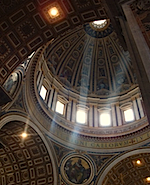 By ALAIN de BOTTON [Apollo] – At the Council of Trent in 1563, Rome issued a decree insisting that, contrary to the impious suggestions of the Protestants, churches, sculptures and paintings should be thought of as integral to the task of ensuring that ‘the people be instructed and confirmed in the habit of remembering, and continually revolving in mind the articles of faith.’ Far from being a distraction, sacred architecture could function as a devotional poem written in stone, timber, and fragments of coloured glass. The Catholic church therefore unleashed a programme of construction and decoration. Alongside the pale, featureless halls of the Reformation, there now arose a new generation of ecclesiastical buildings designed to breathe passionate emotion back into an endangered faith. Ceilings were overlaid with plump cherubs, niches were crowded with saints and heavy stucco mouldings were affixed to ceilings depicting miraculous incidents in Jesus’s ministry.
By ALAIN de BOTTON [Apollo] – At the Council of Trent in 1563, Rome issued a decree insisting that, contrary to the impious suggestions of the Protestants, churches, sculptures and paintings should be thought of as integral to the task of ensuring that ‘the people be instructed and confirmed in the habit of remembering, and continually revolving in mind the articles of faith.’ Far from being a distraction, sacred architecture could function as a devotional poem written in stone, timber, and fragments of coloured glass. The Catholic church therefore unleashed a programme of construction and decoration. Alongside the pale, featureless halls of the Reformation, there now arose a new generation of ecclesiastical buildings designed to breathe passionate emotion back into an endangered faith. Ceilings were overlaid with plump cherubs, niches were crowded with saints and heavy stucco mouldings were affixed to ceilings depicting miraculous incidents in Jesus’s ministry.
To derive a sense of the gulf that opened up between the two branches of Christianity, we need only compare the soberness of the earliest extant Protestant chapel in Schloss Torgau in Germany (1544; Fig. 3) with the ecstasies of the nave vault (‘the triumph of the name of Jesus’) of Rome’s Chiesa del Gesu (1584; Fig. 2). In arguing for the importance of architecture, Catholicism was making a point – half touching, half alarming – about the way we function. The decree implied that we suffer from an aggravated sensitivity to our environment, we will notice and be affected by everything that our eyes alight upon: the fountain, the casino, the flint wall, the iron balustrade – a vulnerability to which Protestantism preferred to remain blind or indifferent. Catholicism was making the remarkable allegation that we need to have good architecture around us in order to become and remain good people.
Cotninued at Apollo [free registration required] | More Chronicle & Notices.





















Post a Comment